 In August 2025, the President Droupadi Murmu has given approval to the Income-Tax Act (I-T Act), 2025 and the same was notified by the Ministry of Law and Justice (MoLJ) through a gazette notification.
In August 2025, the President Droupadi Murmu has given approval to the Income-Tax Act (I-T Act), 2025 and the same was notified by the Ministry of Law and Justice (MoLJ) through a gazette notification.
Exam Hints:
- What? Income Tax Act, 2025 Approved
- Approved by : President Droupadi Murmu
- Effective from: April 01, 2026
- Replaces: Income Tax Act, 1961
- Key Structural Changes:
- Sections reduced: 819 – 536
- Chapters reduced: 47 – 23
- Word count reduced: 5.12 lakh -2.6 lakh
- Major Change: Follow Tax Year.
Background:
Drafting & Reintroduction: The new Income-Tax Bill was drafted in a record 6 months, involving nearly 75,000 person-hours, and first introduced during the Budget Session in February 2025.
- After the Government of India(GoI) withdrew the original Bill on August 8, 2025, it was reintroduced with 566 recommendations of the Select Committee.
Approval: The Lok Sabha passed the Bill on August 11, 2025, and the Rajya Sabha returned it the next day without any amendments.
About Income-Tax Act (I-T Act), 2025:
Implementation : The new law will come into effect from April 01, 2026.
- The new law will replace the decades old I–T Act, 1961, with a modern and simpler version to enhance ease of compliance.
Key Features: The new act does not impose any new tax rate and removes redundant provisions.
Structure: The number of sections reduced from 819 in I-T Act, 1961 to 536 and the number of chapters from 47 to 23.
Modern Tools: The total word count has been brought down from 5.12 lakh to 2.6 lakh.
- For the first time, the Act introduces 39 new tables and 40 new formulas for clarity and ease of reference.
Major Change: A major change in the I-T Act, 2025 is the renaming of the Assessment Year (AY) and Financial Year (FY) to ‘Tax Year’, to avoid confusions.
Key Provisions:
- Retains existing tax slabs (no rate changes), but structures them more logically.
- Introduces a Rs.12 lakh annual Basic Exemption Limit (BEL) with refined slab arrangements for middle-income taxpayers.
- Implements Faceless, Digital-First Assessments (FDFA) to minimize human interface.
- Provides clarifications on House Property (HP) deductions, Standard Deduction (SD), Pre-Construction Interest (PCI), Commuted Pension (CP), Tax Deducted at Source (TDS) certificates, taxation of Anonymous Donations (AD), and rules on Vacant Commercial Property (VCP).
About Income Tax in India:
Origin: Income tax was first introduced in India in 1860 by Sir James Wilson.
- A new Income Tax Act was passed in April 1918, introducing several changes. The 1922 Act became a milestone, shaping the modern tax structure. After numerous amendments, the Income Tax Act, 1961 was enacted in consultation with the Ministry of Law(MoL), providing a uniform framework for income taxation in India.
Constitutional Basis: Income tax in India is governed by Entry 82 of the Union List under the Seventh Schedule of the Constitution of India.
- This empowers the GoI to levy and collect taxes on non-agricultural income.
Administering Authority: The Central Board of Direct Taxes (CBDT), under the Department of Revenue(DoR), Ministry of Finance(MoF), is the administrative authority.
- It is responsible for policy formulation, administration, and enforcement of income tax laws.




